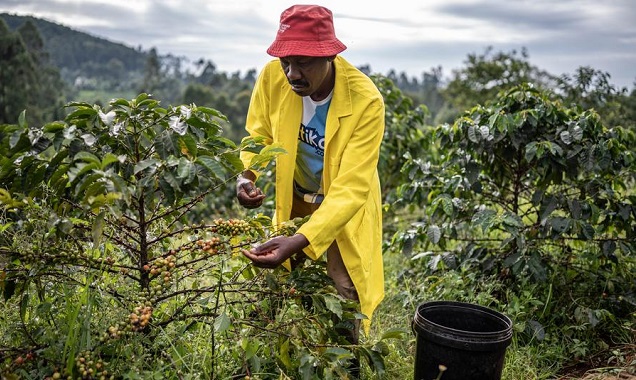
NAIROBI, KENYA | Xinhua | It was just past midday when Richard Muthie stood at the gate of the Mutira Farmers’ Cooperative Society coffee factory, ready to deliver his harvest. Along with the 50-year-old farmer were 30 kg of ripe, red coffee berries freshly picked by him earlier that morning.
Since the start of the year, Muthie has delivered 400 kg of coffee berries for processing at the cooperative’s mill, located about four km from his half-acre farm in Kenya’s central county of Kirinyaga. The land, inherited from his father, has been his source of livelihood. “Coffee provides me with income to meet my household needs,” Muthie said.
Muthie is one of 8,000 smallholder farmers who collectively own the Mutira Farmers’ Cooperative Society. They play a vital role in the cooperative’s operations, which are deeply intertwined with the region’s agricultural rhythms.
Martin Kinyua, the secretary of the cooperative, said that the coffee harvesting season begins in October and typically concludes by year’s end. Farmers then wait for the long rains, expected in March 2025, for the next harvest as their crops depend heavily on rainfall.
In 2023, the cooperative processed about 4.88 million kg of coffee berries from its members. Most of the cooperative’s production was semi-processed and sold in bulk at the Nairobi Coffee Exchange. However, only one percent was fully processed and sold as a final product to local consumers.
To maximize profits for farmers, the cooperative has set an ambitious goal of fully processing at least five percent of their coffee and tap into overseas markets, including China.
Kinyua said that higher earnings have encouraged farmers to expand the land dedicated to coffee cultivation, which is expected to boost the mill’s capacity this year.
Victor Munene, an agronomist at the cooperative, underlined the lucrative potential of coffee farming in the region. “A half-acre piece of land can generate about 96,000 Kenyan shillings (about 742 U.S. dollars) in annual earnings,” Munene said.
He said Kenya is capable of producing specialty coffee, which commands premium prices globally, to its favorable acidic soils.
Statistics from the Kenya National Bureau of Statistics underscore the sector’s significance. In 2023, the country’s coffee production reached 48,648 tonnes, generating about 251.86 million U.S. dollars in exports. Coffee remains one of Kenya’s top foreign exchange earners, alongside tea and horticulture.
For farmers like Kellen Wambui, coffee means a lifeline, rather than simply a crop. The 50-year-old mother of three has been growing coffee for five years. “This year, I have delivered 500 kilograms of coffee berries to the factory,” she said.
Earnings from coffee have enabled her to pay her children’s school fees and meet other household needs.
For younger farmers like Naftali Kinyua Wachira, coffee represents an opportunity for stability and growth. Wachira, 27, was inspired to venture into coffee farming in 2017 after attending meetings at the Mutira Farmers’ Cooperative Society.
On 0.75 acres of the 1.5-acre parcel he inherited from his parents, Wachira cultivates coffee. “Coffee earnings provide a stable income that helps me pay for my education,” he said.
As Mutira Farmers’ Cooperative Society looks to the future, its members see coffee not just as a crop, but as a path to financial independence and community development.
With ongoing efforts to improve processing capabilities and access international markets, the cooperative is setting its sights on ensuring farmers like Muthie, Wambui and Wachira reap benefits from one of the world’s greatest coffee.■
 The Independent Uganda: You get the Truth we Pay the Price
The Independent Uganda: You get the Truth we Pay the Price



